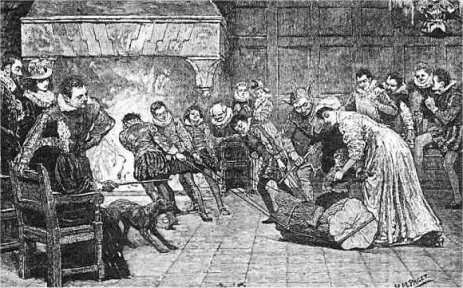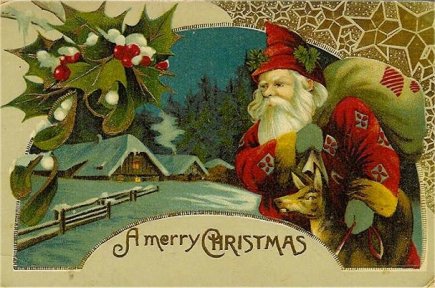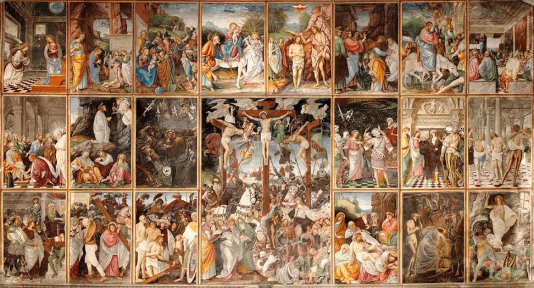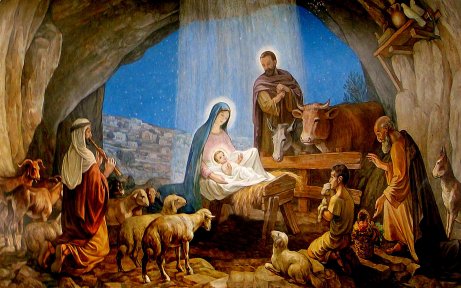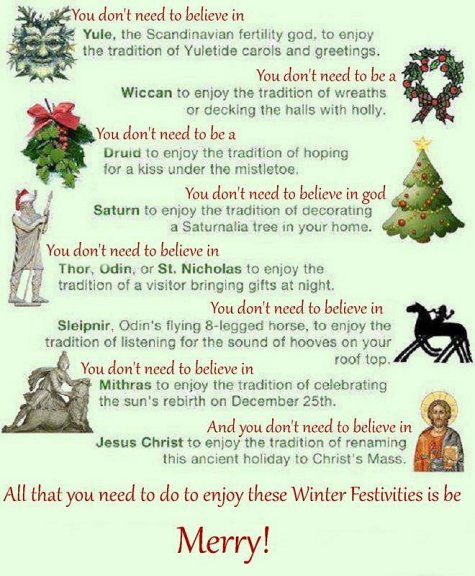Christmas Traditions: Pagan or Christian?
Patheos ~ December 3, 2013 by Jason Mankey
www.hillmanweb.com/xmas/traditions/01.htmlIt’s December which means it’s time to sell books and push the ridiculous narrative that a “War on Christmas” is being waged. There’s currently no war on Christmas, and when there has been a war on the holiday it’s one that has generally pitted Christian against Christian. Christmas is a holiday with numerous traditions and a very long history. Some of that history can be traced to the paganisms of antiquity (perhaps even more so than Halloween), and some of it also arose from Christian tradition.
The modern Christmas holiday arose from a third source as well: secularism. There’s nothing religious about Charles Dickens’ A Christmas Carol and Clement Moore’s A Visit From St. Nicholas (The Night Before Christmas) and both were highly influential in establishing Christmas as the Western World’s most popular holiday over the last two hundred years. Dickens and Moore didn’t invent Christmas, but they popularized the holiday in a completely secular way.
It doesn’t matter where our holiday customs come from, but it’s fascinating (and fun) to trace their various origins. Some of them are only a few hundred years old or less, and some are literally thousands of years old. Decorating with holly doesn’t suddenly make one a Pagan, nor does using the word Christmas make one a Christian. Christmas is a confluence of religious traditions, capitalism, story telling, and the human need to simply connect with those we love. Christmas is more powerful because it reflects a wide range of influences.
What follows are twelve different holiday traditions (of course it had to be twelve, twelve days of Christmas and all that) and an outline of their various origins. At the end of each tradition I render a verdict on whether that tradition is Pagan, Christian, or Secular. It’s all in good fun, but the information is accurate. Happy Holidays!
Holly and Ivy: I’ll always associate holly and ivy together during the Holidays, no doubt due to the song The Holly and the Ivy. Holly remains a popular Christmas decoration with its distinctive green leaves and red berries, but sadly about the only time ivy turns up during the holidays is when someone is singing the song I just mentioned. Decorating with holly (and ivy) is an ancient pagan tradition (1) and was used by the Romans to decorate at Saturnalia celebrations. Like most plants (or trees) on this list early Christians were well aware of the pagan origins of decorating with holly. Pope Gregory the Great even encouraged the continuation of some pagan traditions. In a letter written in 601 CE (Common Era) he wrote:
“The idol temples of that race should by no means be destroyed, but only the idols in them. Take holy water and sprinkle it in these shrines, build altars and place relics in them . . . When this people see that their shrines are not destroyed they shall be able to banish error from their hearts and be more ready to come to the places they are familiar with, but now recognizing and worshipping the true God . . . . .Thus while some outward rejoicings are preserved, they will be able more easily to share in inward rejoicings. It is doubtless impossible to cut everything at once from their stubborn minds . . . .”
As we shall see, Gregory’s advice was taken on more than one occasion when dealing with Midwinter traditions. Verdict: Holly and Ivy are most certainly Pagan Traditions, but to be fair, if you are looking to decorate in December with greenery your choices are pretty limited.
Mistletoe: Mistletoe was a popular decoration at Roman winter festivals and is probably better known for killing Balder in Norse Mythology (darn Loki!) and as an alleged sacred plant of the Druids if Pliny the Elder is to be believed. (2) Ancient pagans most certainly decorated with it, but it didn’t become the kissing plant we are familiar with until centuries later. The “kissing bush” was first popularized in the late 18th Century and originally contained more than mistletoe. Holly, evergreens, fruit, and mistletoe were often bunched together and then hung over doorways to instigate kissing. No one is exactly sure why mistletoe became my favorite doorway ornament, but by the middle of the 19th Century it was a popular custom. (3) Mistletoe, like holly, stays green and produces berries over the winter, making it a natural for Yuletide decoration. Verdict: A little bit of Christian and Pagan. Pagans certainly decorated with it, as did later Christians, but it was Christians who began the kissing custom.
Christmas Tree: The Christmas Tree has a possibly long and tangled history. Ancient Romans and Greeks decorated their homes with evergreen branches and there’s even a Roman mosaic depicting Dionysus with what appears to be an early version of the Christmas Tree. Pagans certainly used evergreens, but pictures of Dionysus aside, no one is completely sure if they used entire trees. Pagans in what is now Poland used to hang evergreen branches from their ceilings and decorate them as well.
There are two early Christian traditions which seem to foreshadow the Yuletide tree. The first is the Paradise Tree, usually an evergreen tree decorated with apples, and used as a prop for Christian mystery (or miracle) plays. December 24 was the old feast day of Adam and Eve so they were often around near Christmas. German families also used to build Christmas Pyramids or Lichstocks, which were wooden frames often decorated with evergreen branches, fruit, and gifts. (4) The first “Christmas Tree” dates back to the early 1520?s in Germany and spread from there, becoming popular in the United States and Britain during the Nineteenth Century. (5) Verdict: Probably mostly Christian, but with a touch of Pagan on the side. I’d love to argue that Dionysus set up the first Christmas Tree but it doesn’t seem all that likely.
Yule Log: The custom of the Yule Log is first documented in Britain in the early 1600?s, where it was first called a “Christmas Log.” Later it was dubbed the Yule Log or sometimes the Christmas block. More than just a giant piece of wood, the Yule Log was part of a large procession before entering a home, ending with a round or four of drinks for everyone who delivered it safe and sound. Many Christmas revelers attached supernatural power to the Yule Log; its burning was said to keep a home safe from harm for the next year. (7) The Norse most likely burned large logs to ward off evil spirits near Midwinter, it’s possible that this tradition led to the development of the Yule Log centuries later. (8) Verdict: Most likely Christian but with Pagan echoes.
Lights and Light: The lights we decorate our homes (and trees) with during the Holiday season have a long history. Ancient pagans lit bonfires and candles on the winter solstice and the holidays around it to celebrate the return of the light. (9) In Christianity holiday lights are represented by Jesus as “the light of the world” and the star above Bethlehem that guided the magi written about in the book of Matthew. Solar deities such as Sol Invictus were also celebrated at Midwinter adding to the solar imagery. Verdict: Most definitely Pagan, though Jesus as the “light of the world” is a nice play on the idea.
Gift Giving: For many folks (especially of the younger variety) the highlight of Christmas is the receiving of gifts. Christians often look to the magi (more famous as “The Three Wise Men”) as the originators of the custom, but pagans were doing it long before Jesus was born. The Romans exchanged gifts at during Saturnalia (a winter holiday lasting the week of December 17-23), including toys and edible treats. (10) For several centuries gifts were given not at Christmas or the Winter Solstice but on New Year’s Day. Queen Victoria didn’t start giving out Christmas presents until 1900, instead she followed the old custom of New Year’s gifts. (11) It’s taken several centuries to slot out the various customs we now associate with Christmas, New Year’s, and Halloween. Verdict: Pagan, but don’t underestimate the power of capitalism for the importance placed on gift-giving during the Holidays. Both Christians and Pagans tended to give little gifts during their Winter revels in the centuries leading up to the modern era.
Santa Claus: The modern Santa Claus arose from a multitude of sources, but the least celebrated and most important is probably the Norse Odin (the Anglo-Saxon Woden). Early pictures of the man we’ve come to know as Santa are closer to the iconography of Odin than that of a Saint from Asia Minor. In the Netherlands Sinter Klaus’s first steed was not a reindeer but a horse, just like Odin. There’s most certainly a trace of the Turkish St. Nicholas in our modern Santa Claus, most notably his generosity, but he contains just a bit more pagan in his DNA than Catholic saint. The Dutch words for Saint Nicholas are Sinter Klaus, which has been corrupted into Santa Claus, so he has that going for him if you’re keeping score at home. Santa Claus’s most famous appearance owes very little to Catholic or Norse myth, and is pure fairytale. Clement Moore’s A Vist From Saint Nicholas is a fanciful and secular take on the figure and has helped shape Santa myth for nearly two hundred years now. The modern appearance of Santa is a gift from Madison Avenue. Verdict: Pagan, but at his best Santa is a wonderful blending of pagan, Christian, and commercial.
Stockings: According to legend Saint Nicholas once helped an old widower provide dowries for his three daughters by anonymously tossing three bags of coins into some stockings. (12) In popular myth, that story of Saint Nicholas is the reason why people hang stockings “by the chimney with care” today, but the inclusion of the stockings are most likely a late addition to the tale. The first (and in some places still the most common) receptacles for toys at Christmas were shoes. In many countries Saint Nicholas still puts presents in hopefully not smelly shoes. Clement Moore wrote about stockings in his poem guaranteeing their prominence in the United States and in some parts of Europe. Verdict: Christian as far as I can tell.
Christmas Cards: The first Christmas Cards were produced in England in 1843, by the 1860?s the custom caught on and began to spread across the pond. The Christmas Card tradition usurped the previous tradition of New Year’s cards, a tradition that dates back to the 1400?s. Christmas Cards also ended up eclipsing the once popular tradition of sending out cards on Valentine’s Day to people other than one’s sweetheart. Early Christmas Cards often used Valentine’s Day imagery. (13) Most early Christmas Cards were completely secular in nature with very few religious depictions. (14) Verdict: Secular, and most likely a money grab, here’s the start of your commercial Christmas.
The Date of Dec. 25: There is nothing in the Bible to suggest that Jesus was born in the winter. The only season slightly implied by the birth narratives found in the gospels is possibly spring due to the inclusion of shepherds, but even that’s just speculation. Christmas is celebrated on December 25 because that date coincided with a whole host of pagan festivals happening around that time of year. In the late Fourth Century the Christian writer Scriptor Syrus commented on the date of Christmas:
“It was a custom of the pagans to celebrate on the same 25 December the birthday of the Sun, at which they kindled lights in token of festivity. In these solemnities and revelries the Christians also took part. Accordingly when the doctors of the Church perceived that CHristians had a leaning to this festival, they took counsel and resolved that the true Nativity should be solemnized on that day.”
The “birthday of the Sun” written about by Syrus was not much older than the Christian Christmas, dating back to only 274 CE, but there were several earlier pagan holidays with connections to Christmas. Mid-December through early January were home to a host of holidays in the old Roman Empire. In addition to Saturnalia there were the Kalendae in January, marked, much like Saturnalia, by merry making, feasting, and the exchange of gifts. Various groups celebrated the “Winter Solstice” from December 21-26 as no one was quite sure when exactly the shortest day of the year occurred. (15)
Northern Europeans celebrated Yule (which could mean “wheel” as in the wheel of the year, or perhaps “sacrifice” or “feast,” all worthy reasons for celebration) at the start of Winter with feasting, drinking, and general merry-making. Drinking might have been the most important of the observances. A poem about Harald Fairhair (the king who unified Norway) makes reference to the king intending to “drink jul (Yule)” even when out of Norway. Ritually passing the drinking horn was said to connect those drinking together to the gods themselves. Most likely there were also sacrifices to the gods and fertility rites, but information is sketchy and comes from mostly Christian sources. Eventually Yule became synonymous with Christmas and now the two words are used interchangeably. (16) Verdict: Most definitely Pagan, as early Christians didn’t celebrate the birth of Jesus for centuries.
The Birth Narratives of Jesus: For many people Christmas is about the birth of Jesus as related in the New Testament gospels of Matthew and Luke. While most historians think that Jesus was very much a real person, the majority of Bible scholars place little faith in the mythological narratives constructed by the authors of Luke and Matthew (even the authorship of those two books is up for debate). Matthew and Luke were written to express certain theological ideas. The first of those is that Jesus is the Jewish Messiah, as such both authors take pains to put Jesus into circumstances they believe were foretold in the Torah. This is why Jesus is born in Bethlehem, and why Luke’s author had to create a census that never happened to get him there. But there are other elements in the two birth stories of Jesus that reflect the pagan religions of the time. Jesus was born in humble circumstances (at least in Luke) but was born due to the mingling of mortal and divine; Jesus had a god for a father and a mortal for a mother, just like most ancient pagan gods who walked the Earth. There’s nothing particularly Christian (or Jewish) about the magi (later they would become the Three Wise Men and be given names) either, and they could be a reference to the proto-monotheism of the Zoroastrian faith. When gods were born in ancient mythology their arrival was often marked by miraculous occurrences, these occurrences are mimicked in the New Testament with the Star of Bethlehem and angels heralding the birth of Jesus. This is not to suggest that the rest of the gospels depict Jesus as some sort of ancient pagan deity, they do not, but the birth stories in Matthew and Luke do, at least a little bit. Verdict: A tie. There are certainly pagan elements in the story, but there’s also a lot of stuff related to Jewish prophecy and even some original thinking. The “first Christmas” of Jesus, Mary, and Joseph isn’t much different than our modern ones, a combination of many things.

The Magical History Of Yule,
The Pagan Winter Solstice Celebration
“After the longest night, we sing up the dawn.”
Ref: HuffPost Religion Editors The Huffington Post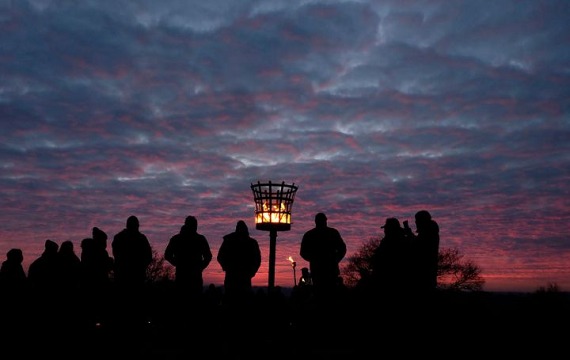
The Charnwood Grove of Druids gather for a public winter solstice ritual
on Beacon Hill near Loughborough, BritainThe winter solstice is celebrated by many people around the world as the beginning of the return of the sun, and darkness turning into light. The Talmud recognizes the winter solstice as “Tekufat Tevet.” In China, the Dongzhi Festival is celebrated on the Winter Solstice by families getting together and eating special festive food.
Until the 16th century, the winter months were a time of famine in northern Europe. Most cattle were slaughtered so that they wouldn’t have to be fed during the winter, making the solstice a time when fresh meat was plentiful. Most celebrations of the winter solstice in Europe involved merriment and feasting. In pre-Christian Scandinavia, the Feast of Juul, or Yule, lasted for 12 days celebrating the rebirth of the sun and giving rise to the custom of burning a Yule log.
In ancient Rome, the winter solstice was celebrated at the Feast of Saturnalia, to honor Saturn, the god of agricultural bounty. Lasting about a week, Saturnalia was characterized by feasting, debauchery and gift-giving. With Emperor Constantine’s conversion to Christianity, many of these customs were later absorbed into Christmas celebrations.
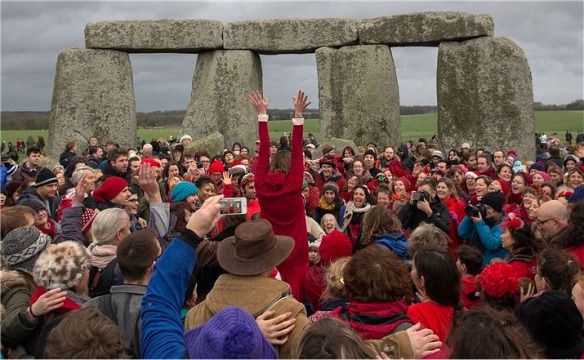
Revelers celebrate the winter solstice at Stonehenge on December 22, 2015.
Stonehenge is a celebrated venue of festivities during the winter solstice -
the shortest day of the year in the northern hemisphere -
and it attracts thousands of revelers, spiritualists and tourists.
Druids, a pagan religious order dating back to Celtic Britain,
believe Stonehenge was a center of spiritualism more than 2,000 years ago.One of the most famous celebrations of the winter solstice in the world today takes place in the ancient ruins of Stonehenge, England. Thousands of Druids and Pagans gather there to chant, dance and sing while waiting to see the spectacular sunrise.
Pagan author T. Thorn Coyle wrote in a 2012 HuffPost article that for many contemporary celebrants, solstices “are a chance to still ourselves inside, to behold the glory of the cosmos, and to take a breath with the Sacred.”
In the Northern hemisphere, friends gather to celebrate the longest night. We may light candles, or dance around bonfires. We may share festive meals, or sing, or pray. Some of us tell stories and keep vigil as a way of making certain that the sun will rise again. Something in us needs to know that at the end of the longest night, there will be light.
In connecting with the natural world in a way that honors the sacred immanent in all things, we establish a resonance with the seasons. Ritual helps to shift our consciousness to reflect the outer world inside our inner landscape: the sun stands still within us, and time changes. After the longest night, we sing up the dawn. There is a rejoicing that, even in the darkest time, the sun is not vanquished. Sol Invictus — the Unconquered Sun — is seen once again, staining the horizon with the promise of hope and brilliance.
BACK TO THE HILLMAN CHRISTMAS PAGE

www.hillmanweb.com/xmas
19 Favourite Secular Christmas Songs



